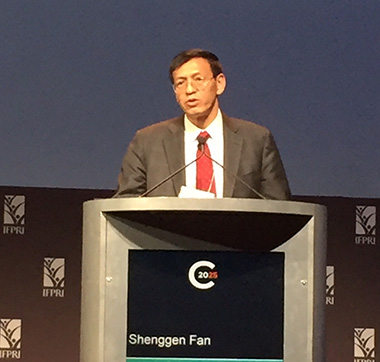The following story was originally published on Lawrence Haddad’s Development Horizons blog.
When I joined IFPRI as a research assistant in 1984 IFPRI was only 9 years old (I was a bit older). This past week IFPRI celebrated its 40th birthday: looking back and looking forward.
A quote from an unknown source about being 40 says “At 40, you sing along with the elevator music”. IFPRI will never be guilty of that—it will always shun bland elevator fare and strive to write vital, original and melodic music.My three stints at IFPRI total 18 years. It is a great institution, doing cutting edge conceptual and empirical research that aims to be impactful (and frequently is). What more could a researcher want?
To Date
The successes that stand out for me (and this is very partial—it is only from one of the four research divisions and from less than half of IFPRI’s 40 years) include:
- the work on the commercialization of agriculture (it does increase income and food security, but only fitfully improves nutrition status—although it does not reduce it)
- the research on women’s control of resources (greater control is seriously good for women, for their children—and for the whole family)
- the evaluation of Progresa, the first big conditional cash transfer, from Mexico in the late 90s which helped popularize social protection and rigorous impact evaluations
- the careful evaluations of nutrition interventions, not only on the what, but also the how and why
- biofortification of staple crops with iron, zinc and vitamin A through conventional breeding processes (increasing yield as well as bioavailable micronutrients)
The biofortification work led by Howarth Bouis (Director of HarvestPlus), is just very impressive. Like all great ideas, it just seems so simple in hindsight: select germplasm for micronutrient content as well as for yield. Nearly all of the plant breeders said it could not be done, but Howarth refused to take no for an answer and eventually found a plant breeder at Cornell, from outside the CGIAR, who said it could be done. And it was. This work may have the biggest legacy of all the work I have seen at IFPRI. Not only has it changed the way people think, it has led to scalable interventions that will directly improve people’s lives and, in many cases, save them.
The Future
But what of the future? The 60 + short presentations at the all-day (and not quite all-night) 40th event found it harder to peer into the murky future than to reflect on the warmly remembered past. This is not surprising—it is always much more difficult to predict what is coming around the bend than to look in the rear view mirror.
I found four things particularly important:
- The need to remember that food policy goes beyond agriculture policy and food price policy. Agriculture will always be a vital component of a food system, but it inevitably will become a smaller part. In the years to come, what happens between farm and fork will garner more and more energy, money and innovation. That journey is getting longer and longer, so it needs to be understood and when markets fail, policy needs to step in to guide outcomes toward healthier diets. We need more research on what those policies look like.
- Urbanization. So many speakers focused on this–it was striking. IFPRI tried to get a serious research programme going on this in the late 90s, but there was no real traction from research funders. Now the time seems right. The urban area is probably more complex than the rural, is certainly less researched, and is possibly more fluid. Doing research in urban areas will be really valuable because the rapidly growing smaller cities may be able to implement some of the policies equally rapidly and even in big established cities, a small improvement in a policy, because of population size and density, could have a big impact. But, for sure, working in an urban context will challenge the assumptions, biases and experiences of most food and nutrition policy researchers whose formative research experiences were probably largely in rural areas.
- How to formulate policy in a natural resource constrained world? Most policy research until the last 5 years in food and nutrition acted as if our policies do not use water, or minerals in the soil, or energy. Well they do, and the constraints are increasingly binding. What can be done to give food policy a lighter resource footprint? As a first step, we need to incorporate these costs in estimates of growth, whether growth of countries or businesses or big NGOs.
- Understand implementation better. How to convert plans into high impact actions that are carried out? On the one hand as the size of governments grow due to increased tax revenues from economic growth, their implementation responsibilities are greater in scope. On the other hand more and more governments are decentralizing implementation and so the capacity for that is being dispersed. The why and how of implementation will become more prominent in research, perhaps with more cross learning between low middle and high income countries.
Happy Birthday
40 is a great stage in life—still youthful enough to have lots of energy to try new things without being bashful, but old enough to have the wisdom and experience to understand all the possibilities, how to assess them, and when to expand them.
That is the place IFPRI needs be in—experimental, but driven by the very serious goal of ending hunger and undernutrition by 2025 (e.g. the new Compact 2025 flagship).
By working with its hundreds of partners, I have no doubt that IFPRI will rise to the occasion — now and in the coming years.







